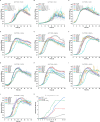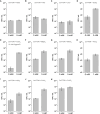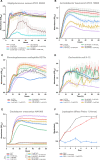Divalent Cations (Ca2+, Mg2+, Mn2+, Fe2+, Ni2+, and Zn2+) Enhance Growth of Xanthomonas citri and X. campestris by Reducing Generation Time
- PMID: 40852258
- PMCID: PMC12368633
- DOI: 10.1021/acsomega.5c02786
Divalent Cations (Ca2+, Mg2+, Mn2+, Fe2+, Ni2+, and Zn2+) Enhance Growth of Xanthomonas citri and X. campestris by Reducing Generation Time
Abstract
Bacterial ion homeostasis is critical for adaptation and survival. In this study, we show that supplementing 2xTY medium with divalent cations (Ca2+, Mg2+, Mn2+, Fe2+, Ni2+, and Zn2+) from 50 to 1,000 μM significantly enhances the growth of Xanthomonas species by reducing generation time, while monovalent ions (Na+, K+, Li+, and Cl-) had no significant effect. Among them, Ca2+ effectively boosted X. citri fitness, increasing the specific growth rate by up to 223%, shortening the cell cycle, and enhancing adhesion to abiotic surfaces up to 8-fold. Calcium also induced a more uniform and smaller cell morphology, suggesting improved cell division and metabolic efficiency. Colony forming unit counts confirmed a higher viability, excluding dead cell accumulation. These effects were conserved in other Xanthomonadaceae members (X. campestris and S. maltophilia) but not in nonrelated species. Based on these findings, we propose an optimized growth medium named 2xTY-Ca (16 g/L tryptone, 10 g/L yeast extract, 5 g/L NaCl, and 1 mM CaCl2), which significantly improves Xanthomonas spp. growth kinetics in vitro, enhancing X. citri and X. campestris cultivation for laboratory and industrial applications. Though the precise molecular mechanism behind these phenotypes has yet to be determined, we highlight X. citri as a promising organism to understand the role of divalent cations in bacterial physiology.
© 2025 The Authors. Published by American Chemical Society.
Figures






References
-
- Yurinskaya V. E., Vereninov A. A.. Cation-chloride cotransporters, Na/K pump, and channels in cell water/ionic balance regulation under hyperosmolar conditions: In silico and experimental studies of opposite RVI and AVD responses of U937 cells to hyperosmolar media. Front. Cell Dev. Biol. 2022;9:830563. doi: 10.3389/fcell.2021.830563. - DOI - PMC - PubMed
-
- Zheng X., Cheng W., Ji C., Zhang J., Yin M.. Detection of metal ions in biological systems: A review. Rev. Anal. Chem. 2020;39:231–246. doi: 10.1515/revac-2020-0118. - DOI
LinkOut - more resources
Full Text Sources
Miscellaneous
